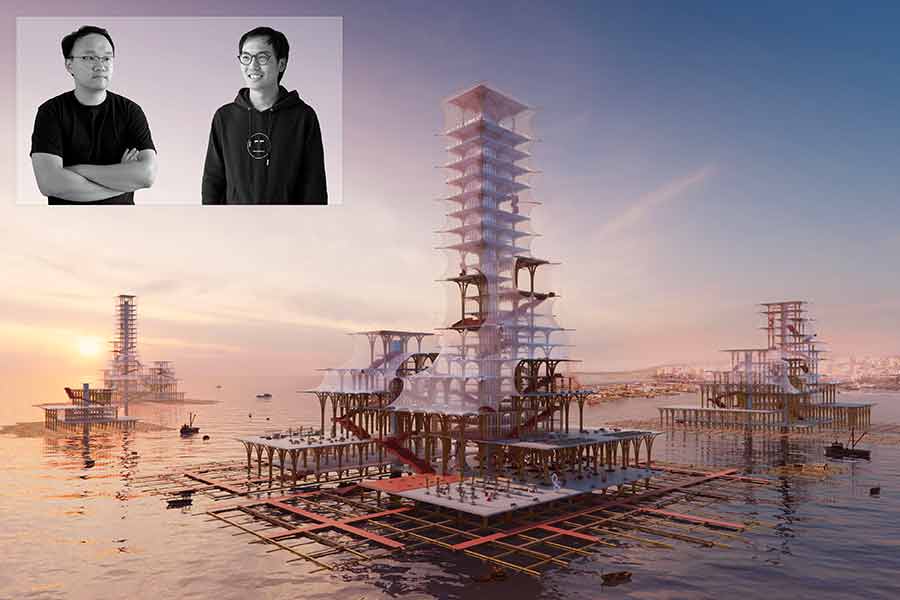Renyi Zhang and Xianming Sang, two highly experienced architects with backgrounds from the Harvard University Graduate School of Design, have come together to create an innovative and sustainable settlement proposal for the Dan Family in Hainan Province, China. Renyi Zhang, an architect and urban designer, has contributed to a range of high-profile projects across the U.S., working with prestigious firms like Sasaki and Perkins&Will.

His expertise spans national and international projects, blending urban design with sustainable architecture. Xianming Sang, also a distinguished architect, brings his vast experience from working with notable firms such as Perkins + Will, OMA, and Junya Ishigami. He specializes in designing large-scale office and residential buildings and has a keen eye for creating spaces that elegantly house art exhibitions and fashion shows.
Their collaborative proposal, aimed at addressing both environmental sustainability and cultural preservation for a growing coastal community, has been recognized with prestigious awards, including the Muse Gold Award and the A Design Award in 2024. This recognition underscores the proposal’s innovative approach to sustainable community planning and architectural excellence.
Interviewer: Today, we are joined by pioneer designers Renyi Zhang and Xianming Sang to discuss their groundbreaking proposal for a sustainable settlement in Hainan Province, which aims to address both the environmental challenges and the cultural heritage of the Dan Family. Welcome, Renyi and Xianming.
Renyi Zhang: Thank you for having us.
Xianming Sang: It’s a pleasure to be here.
Interviewer: To begin, can you give us an overview of the challenges faced by the Dan Family and what prompted this innovative design?
Renyi Zhang: Certainly. The Dan Family has a unique history of settling along the coastline due to historical restrictions on their land use. Over the years, their population has grown significantly, which has led to unplanned settlement sprawl and significant environmental challenges. These include pollution from traditional fishing methods and the pressures from tourism and other industries.
Xianming Sang: Our design proposal aims to create a sustainable, adaptable, and culturally sensitive solution that considers both the environmental impact and the community’s traditional way of life.
Interviewer: What are the key elements of your design proposal for the new settlement?
Renyi Zhang: Our proposal includes a fishery skyscraper that functions as a vertical community. It integrates multi-level recyclable systems for energy, water, and materials. This includes modular production typologies for aquaculture that minimize external inputs and maximize waste reuse within the system.
Xianming Sang: To add to that, the design also focuses on renewable energy generation, utilizing solar, tidal, and bioenergy. The structure itself is made from recycled materials from deconstructed fishing clusters, which reduces environmental impact further.
Interviewer: How does your design address the cultural and social aspects of the Dan Family community?
Renyi Zhang: It was crucial for us to respect and integrate the Dan Family’s cultural heritage into our design. We have included communal spaces such as a clan temple and a Mazu temple, which are significant to their marine-based religion and communal identity.
Xianming Sang: We’ve also incorporated commercial and touristic spaces that promote the Dan Family’s fishing and seafood industries, while also providing areas for cultural exhibitions and community gatherings. This creates a living museum of their cultural heritage.
Interviewer: Can you elaborate on how the settlement will manage environmental issues?
Xianming Sang: One of the innovative aspects of our design is the closed-loop system for managing organic and inorganic waste. Organic waste from aquaculture is processed into biogas, which in turn powers the settlement. Inorganic waste is recycled and used in building materials and to restore local ecosystems, like mangroves.
Renyi Zhang: Additionally, our approach to energy is to generate as much as possible on-site. The design includes photovoltaic installations and uses tidal energy, which are both abundant in the region.
Interviewer: What future impacts do you foresee with the implementation of this project?
Xianming Sang: We believe this project can be a model for sustainable coastal development worldwide. It shows how communities can live in harmony with their environment and leverage their traditional practices in a modern context.
Renyi Zhang: Yes, and beyond the environmental and cultural benefits, this project is about building resilience. It’s about empowering the Dan Family to adapt to modern challenges while maintaining their unique identity.
Interviewer: Finally, what are the next steps in bringing this visionary project to life?
Renyi Zhang: The next steps involve further refining our designs with input from the community and environmental scientists. We also need to secure funding and governmental support, which are crucial for such a pioneering project.
Xianming Sang: We’re also looking at ways to scale and replicate this model in other similar communities globally, which face the same challenges of environmental sustainability and cultural preservation.
Interviewer: Renyi, Xianming, thank you both for sharing your insights and details about this fascinating project.
Renyi Zhang & Xianming Sang: Thank you for having us.
